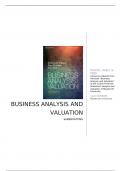Samenvatting
Summary "Business Analysis and Valuation"
- Instelling
- Maastricht University (UM)
Concerns a summary of the book "Business Analysis and Valuation". The summary is based on the material of the course Financial Statement Analysis and Valuation of the Accounting & Control program at Maastricht University. The summary includes chapters 1 through 8 (so the whole book except chapters ...
[Meer zien]














